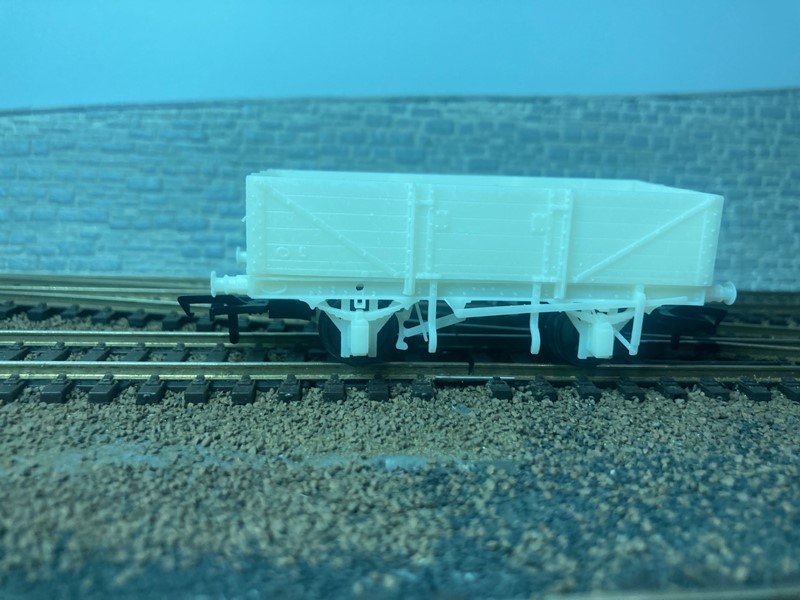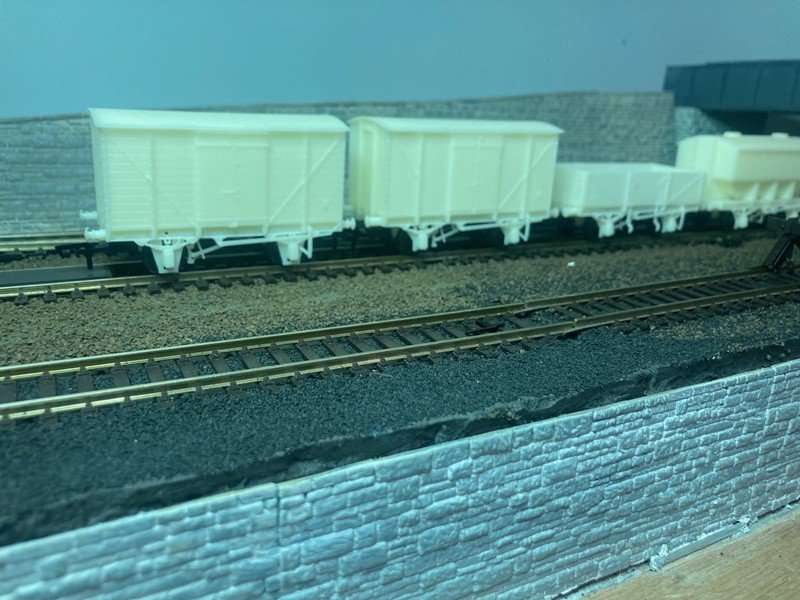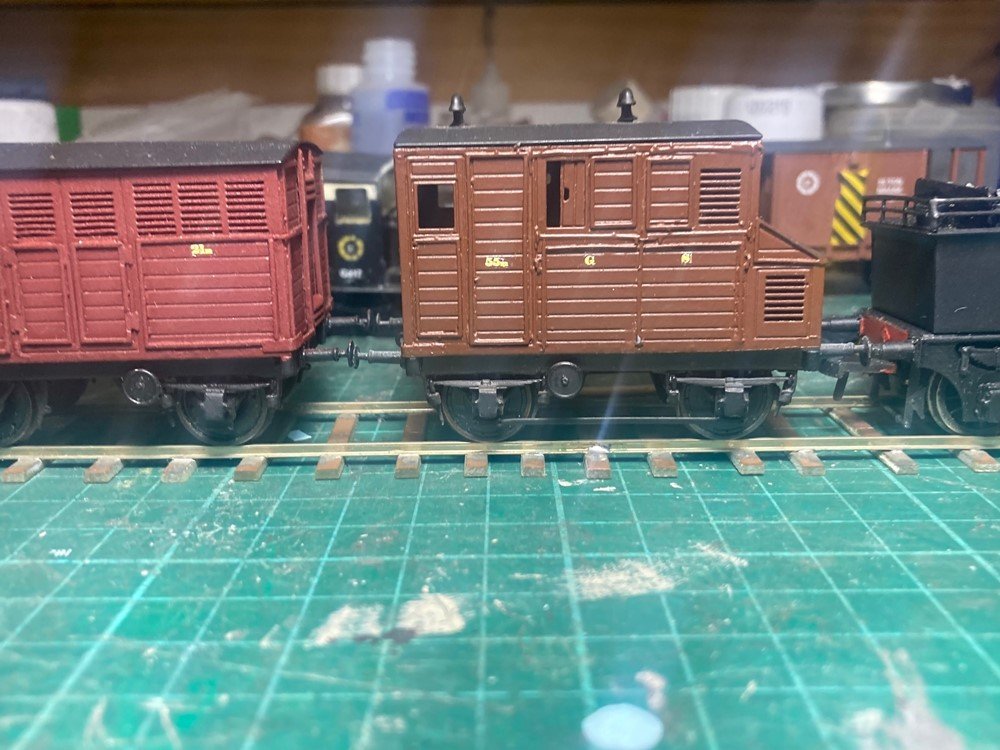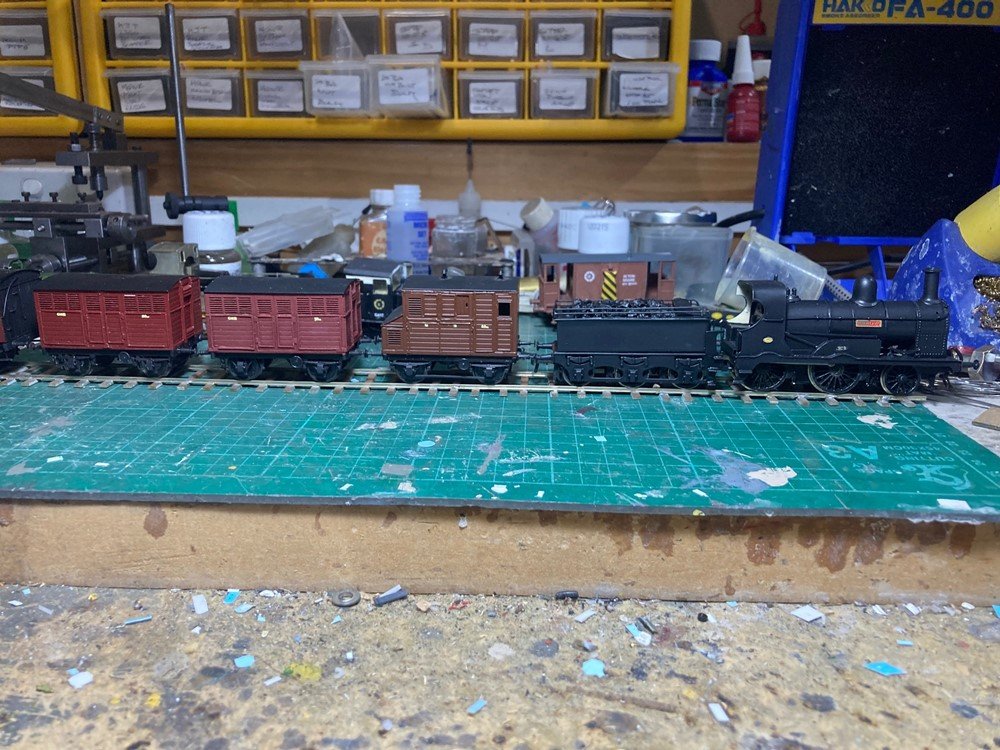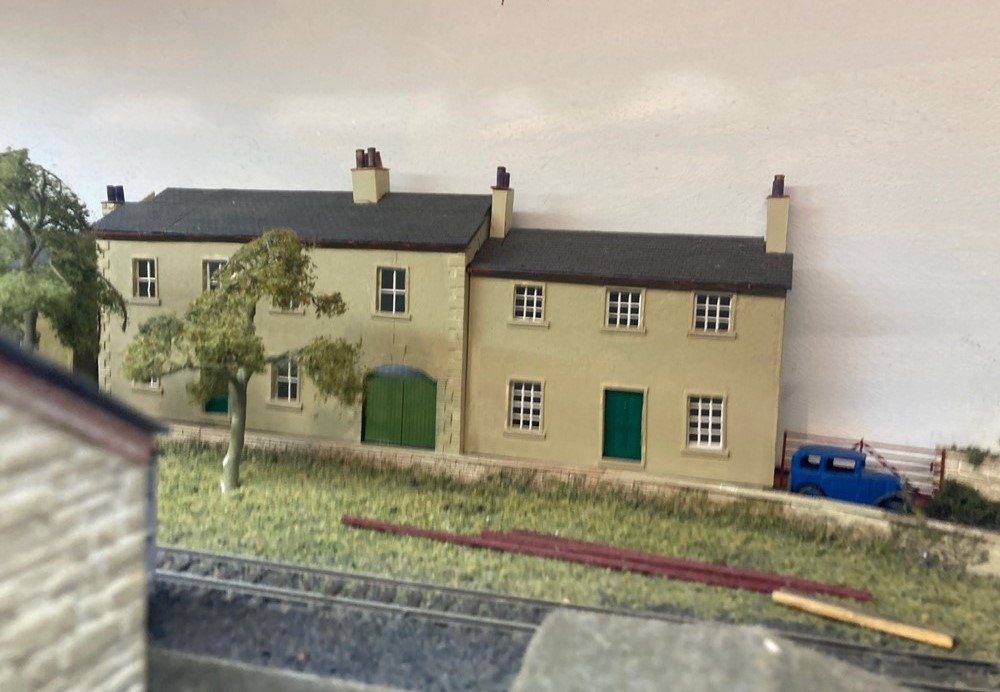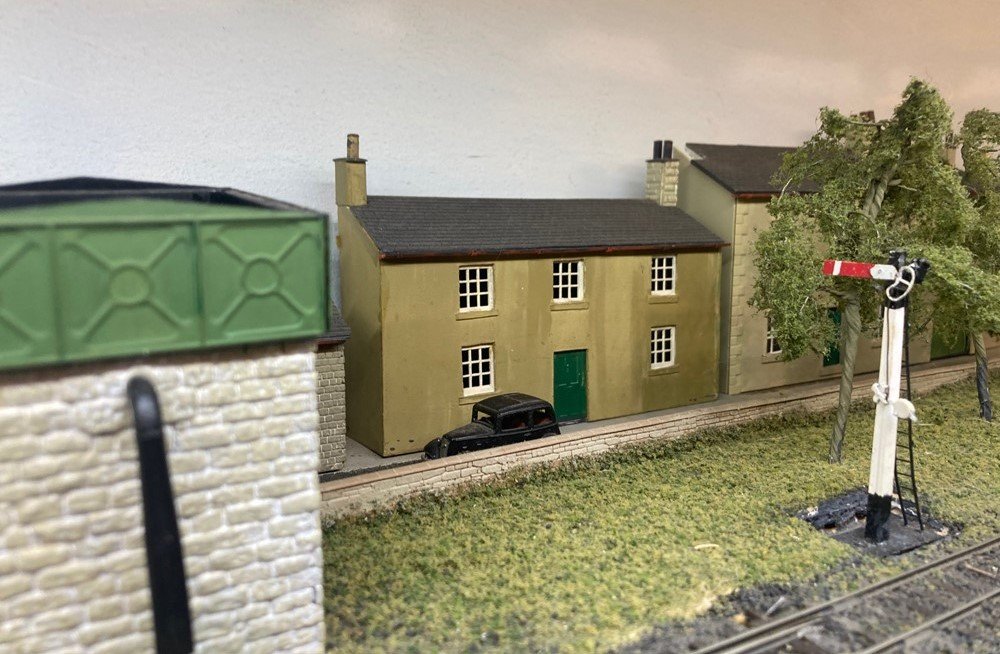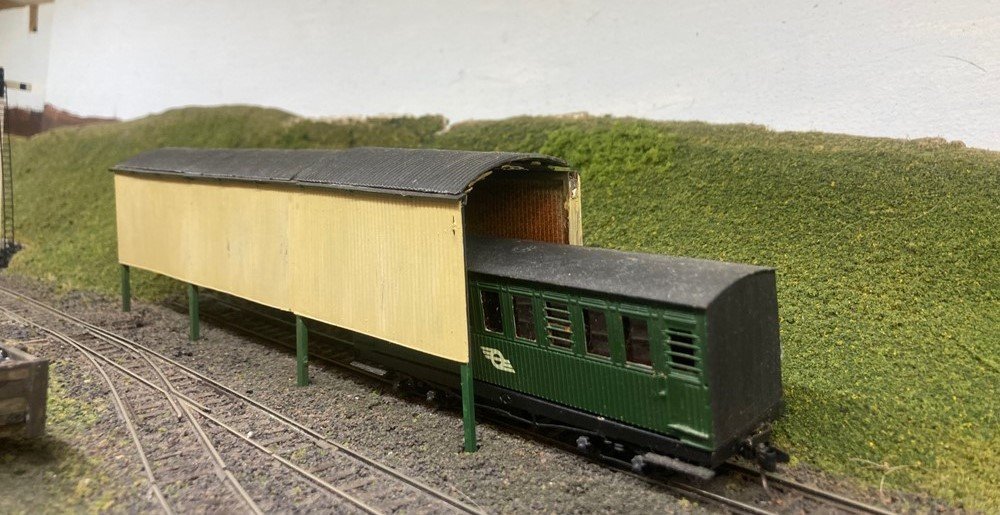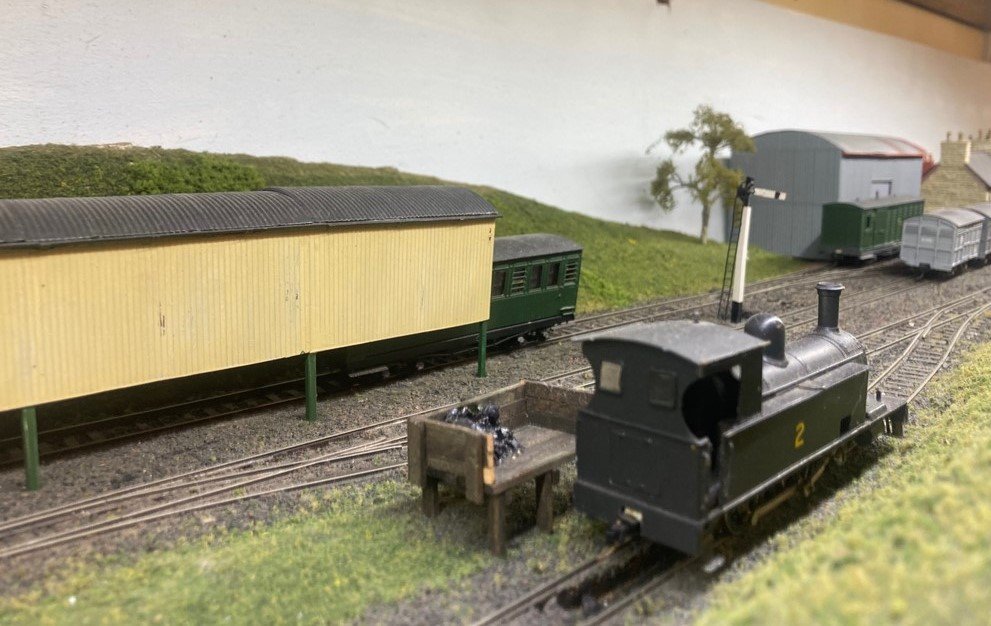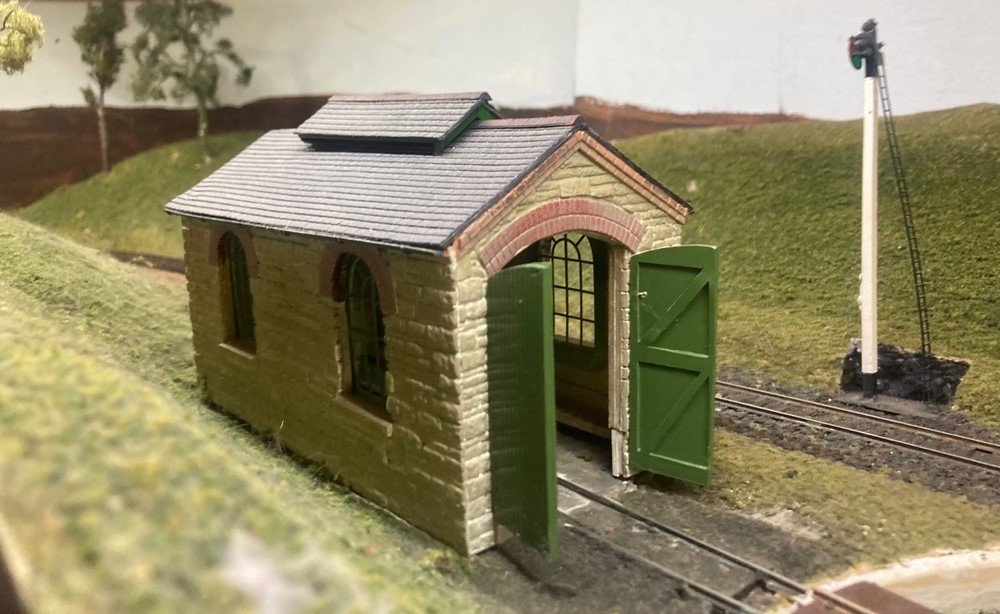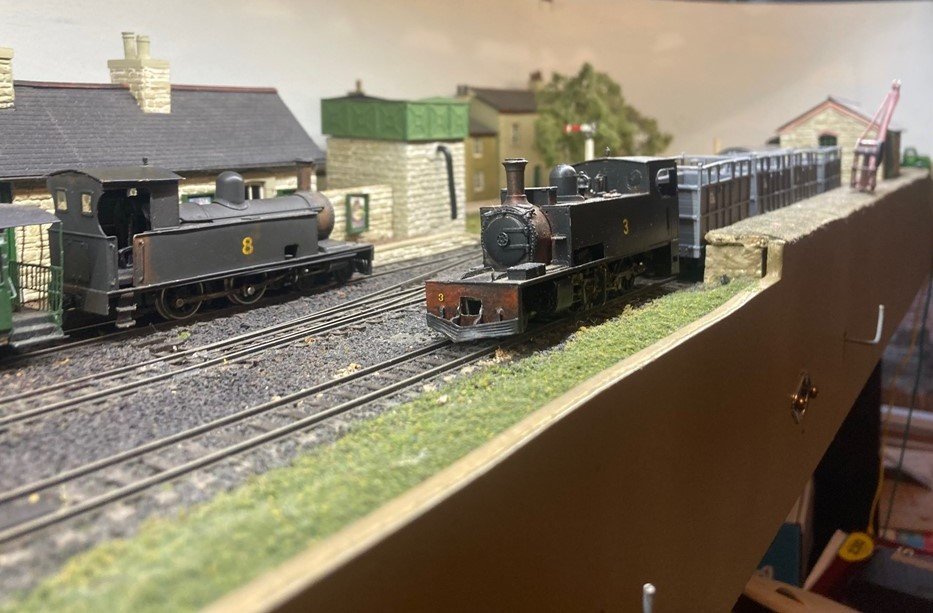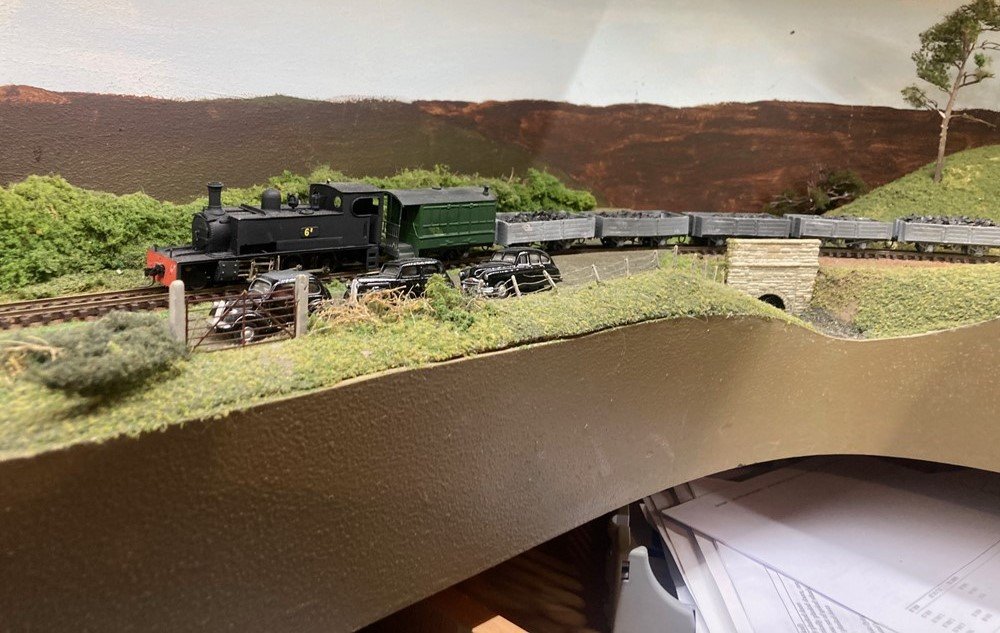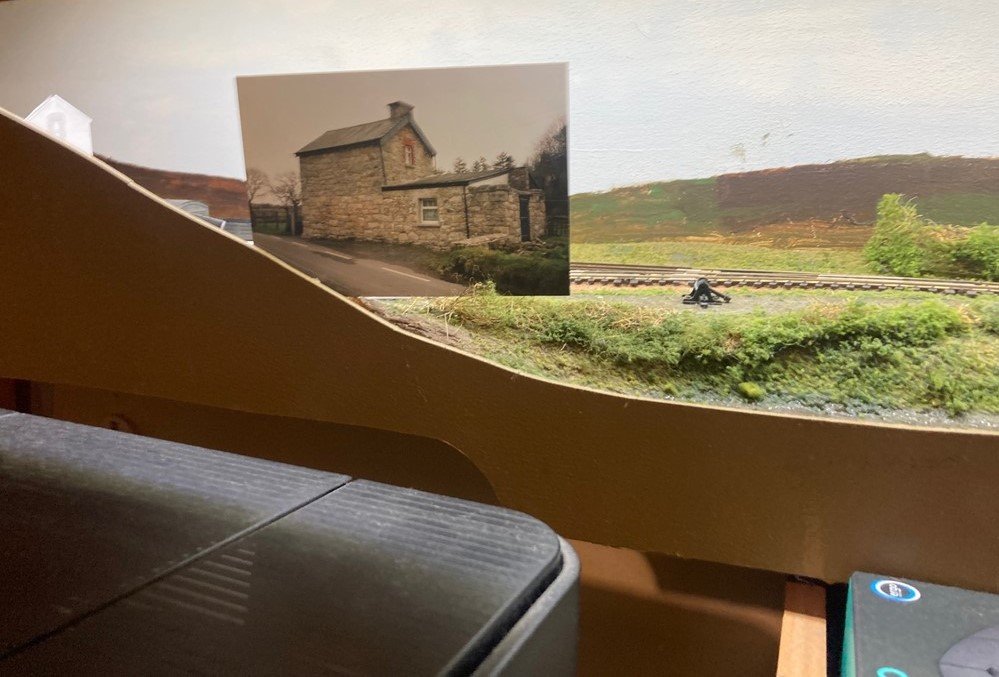-
Posts
4,857 -
Joined
-
Last visited
-
Days Won
119
Content Type
Profiles
Forums
Events
Gallery
Blogs
Store
Community Map
Everything posted by Mayner
-
The Donegal Articulated railcars appeared during the early 90s, I assembled a model of Railcar 14 over Christmas in Ireland in 93, I was living in Scotland at the time and Glasgow Airport security inspected the un-built kit while flying out to Dublin and the completed model upon my return to Scotland. I moved back to the Home Counties 12 months later and picked up the newly introduced C&L 4-4-0T, brake vans and wagons at the Greenwich Narrow Expo, I bought another 4-4-0T and several more wagons before returning to Ireland in late 95 and spent most of my evenings in February-March 96 assembling them in Carrick on Shannon. I never had problems with back up support with Backwoods, Pete supplied a replacement layshaft for the railcar power bogie, the original was too short. The most annoying thing about the kits was that the wagon/coach wheels were supplied loose and had to be fitted to their axles, the 2 stage drive to the railcar power bogies were fiddly to assemble but fundamentally sound, the gear-box in the C&L 4-4-0T used modified Graham Farish N gauge gears and ended up replacing the gearboxes in both my locos with Branchlines Slim-line Gearboxes to achieve reliable slow speed running, I also managed to wreck the Farish worm on one of the locos.
-

Ernies Massive Irish 1930's to 2005 Photo Archive
Mayner replied to Glenderg's topic in Photos & Videos of the Prototype
The mixed gauge wagon turntable was used for swapping the bodies of "Tranship Wagons" an early form of "Swap Body" between the broad and narrow gauge, the underframe of a narrow gauge Tranship Wagon" is on one of the turntable roads. The narrow and broad gauge tranship wagon underframes were fitted with rollers and drop down end posts to allow tranship wagon bodies to be transferred from the Broad to the Narrow Gauge and vice versa. It looks like the Donegal mainly used containers (its own and GNR) for through traffic travelling "under bond" through Northern Ireland converting redundant coach underframes into bogie container wagons a good 20 years before CIE introduced bogie container wagons! The CDR & GNR only appear to have had a small number of Tranship wagons, one of the main tranship traffics from the narrow to the broad gauge appears to have been road stone in open 'Tranship wagons". -
Love the backscene. I basically have a cat flap (side hung) arrangement to link the G gauge storage tracks in the garage to a large oval around the garden, has given me somewhere to run trains for the past 15 years The garden railway fraternity tend to operate year round regardless of location or climate with a large following in the UK. Garden Railway Specialist, Princes Risborough is well worth checking out and highly addictive https://www.grsuk.com/
-
The Backwoods Miniatures website is still accessible although the owner Pete McParlin suspended trading in December 2016 http://www.backwoodsminiatures.com/00n3kits.htm The Irish OOn3 models were introduced in the early-mid 1990s. Sales of the Irish models appear to have been disappointing (apparently only selling one CVR Loco) Pete later focused on OO9 and American outline models, later commissioning rtr Brass /n30 locos from the Far-East.
-
We have received our first production order from a new supplier and we are now able to sell our 3D printed wagons at a lower price point! Our new supplier has the capability to print models in engineering resins including an ABS-like resin similar to that NZ based company that carried out some of our original prototyping and production, though to a higher resolution. I have a small number of open wagons, vans and grain wagons available from stock, but I will be in the States visiting family and friends and won't be able to process orders from late June to Mid July. https://jmdesignmodelrailways.com/blogs/news The label clip and oval plate which our previous supplier struggled to print is now clearly defined. GSWR van detail clearly defined few 'tell tale" signs of 3D printing. A small number of CIE & GSWR Vans, Standard Open and GSR Bulk Grain are currently available from stock. Unfortunately a batch of Brake Van bodies were badly damaged in the post and unusable.
- 2 replies
-
- 14
-

-

-

Abbey Jnct Signal Box being removed.
Mayner replied to Wexford70's topic in What's happening on the network?
I was critical of the posters whinging about "The Heritage Office/IE" and not looking at the bigger picture, not your reporting that cabin is being removed in connection with planned development of the new station. The cabin is a small timber framed structure and fairly easy to move/re-locate without damage. I am not sure if the lever frame is intact, when I last visited the cabin about 20 years ago it was being used simply as a crossing cabin to control the Level Crossing, possibly 2 levers controlling the distant signals protecting the crossing Block Instruments and signal interlocking controlling the Junction with the New Ross Line and Frank Cassin Wharf had been removed -

Abbey Jnct Signal Box being removed.
Mayner replied to Wexford70's topic in What's happening on the network?
The main function of the Heritage Office was to tick the box in terms of recording the 'Hertiage" element of the railways in the planning and execution of the big projects and route modernisation schemes of the late 90s early 2000s. The Government was prepared to spend public money on the Passenger railway in terms of increasing route and train capacity, replacing worn out rolling stock and infrastructure. Its interesting that people on this thread are getting more worked up about the removal of a standard GSWR signal box than a major investment in a new Waterford Station and Transport Hub https://www.waterfordcouncil.ie/media/projects/public-consultations/sdz-transport-hub/Part VIII Report Main-Document.pdf. It would be stretching it a bit to justify '"preserving" Abbey Junction Signal Box within a context of an operational railway" with the City, County Council and IE showing joined up thinking about private and public transportation with a new two platform station on the site and an overbridge replacing the existing level crossing and filling station. -
Those small GNR 0-6-0s make nice simple models for a scratchbuilding project with nice simple geometric shapes, cylinders, rectangles, flat running boards, in contrast to the Southern and Midland Standard goods with their curving running boards and mass of rivet detail of GSWR and Beyer Peacock designs. Nice to see the great scratchbuilding tradition is alive and well among the modellers of Ulster's railways
-

Clogherhead - A GNR(I) Seaside Terminus
Mayner replied to Patrick Davey's topic in Irish Model Layouts
Almost looks like it was shut down by the Food Standards people or District Health Board. -
Apparently York Road 'borrowed' 186 for works/station pilot duties after she first 'went North" during the 1960s. Loco crews who were apparently impressed by the J15s power and sure-footedness and wanted to hold on to 186 as a shunting loco.
-

Clogherhead - A GNR(I) Seaside Terminus
Mayner replied to Patrick Davey's topic in Irish Model Layouts
Although born and bred in Dublin never actually visited Clogherhead, nearest were childhood trips by car to the seaside at Gormanstown and a couple of visits to Butlins with friends in my early teens including one by train returning non-stop Mosney-Connolly in an ex-GNR K15 coach, first journey on a fast train being used to AEC railcars on Connolly-Bray subbies. Its possible Clogherhead might have become a GNR equivalent of the BCDR Ardglass a Light Railway branchline serving a quiet seaside terminus and fishing port possibly with a couple of morning and evening peak-hour Dublin-Drogheda services running through to Clogherhead for season-ticket holders and day-trippers, only light axle locos like U & UG and similar small locos allowed over the line because of its light railway heritage. Possibly some of the entrepreneurs/political figures behind Ireland's drive for self-sufficiency during the 1930 (ESB,CSE,BNM etc) though an Irish equivalent of Butlins or Pontins may not be a bad idea. -
Fair play Alan for forming the skirts where the chimney/dome sit on the smokebox/boiler, its something I haven't been able to get my head around physically using a lathe or in CAD work for 3D printing. You appear to be able to build a loco from scratch than I can assemble a kit. Interestingly I originally though the BCDR 0-6-4T was based on the "Large Leitrim Tank" design and did not realise it was a completely different design until I noticed the longer distance between the driving and trailing axle on your model than on the Leitrim (& South Australian) locos and realised the BCDR loco was not a "Long Boiler' type with the firebox placed behind the rear driving axle.
-
The IRRS Flickr site is a great resource for modelling the C&L, seemingly every enthusiast/photographer visited the line and recorded every loco and item of rolling stock in great detail. 3D printing is probably the best option for producing wagons and possibly coaches, white metal or resin casting from metal or plasticard patterns is not really a viable option in this day and age. Etched metal or scratchbuilding is likely to remain the only viable option for producing locos, putting a C&L 4-4-0T, Passage 2-4-2T or Kerry 2-6-0T/2-6-2T on a TT gauge chassis is unlikely to work. The main drawback with the Backwoods kits is that the models are based on 30 year old technology, and chassis/gearboxes would require upgrading to allow the locos to operate reliably and Pete incorporated a number of significant errors/oddities in his C&L kits. While the C&L 4-4-0T builds into a nice model capable of running reliably, the large square coaling flap in the rear of the cab is completely incorrect, as the locos had a pair of relatively tall rectangular doors. Similarily the 4w Passenger Van is a hybrid that incorporates a mixture of original and simplified panelling and can be assembled with the original Birdcage look out, the Convertible Wagon is based on a wagon that had original doors with the original outside framing on one side and a half-door arrangement on the opposite side with one leaf with the original outside framing and the other replaced with vertical planking, I ended up buying 4 C&L vans to build 2 with doors in original condition and replaced the half/paneled doors on the remaining two with vertical planked plasticard. Quality and durability with 3D printed models is pretty much a case of selecting a printer (printing bureau or a physical printer) capable of printing small scale models in suitable materials to fine tolerances, something home desktop and some commercial printers will struggle to achieve.
-

Ernies Massive Irish 1930's to 2005 Photo Archive
Mayner replied to Glenderg's topic in Photos & Videos of the Prototype
Train consist includes what looks like an ex-GSWR 12w "Rosslare Route" Dining Car 353 of 1906 and recently introduced Craven stock. 353 appears to have been withdrawn in 1968. Possibly an IRRS specials in connection with the closure of the Mallow-Waterford line and the diversion of the Boat Trains to run via-Limerick Junction and the introduction of mechanical staff exchange (snatchers) on the Waterford West-Limerick Junction section of the W&L line. -
Peco HOm (1:87-12mm) track is probably the best option for OOn3. TT (1:120) is a standard gauge system and looks like standard as opposed to narrow gauge with smaller sleepers spaced closer together. For many years Parkside-Dundas now Peco have produced high quality plastic injection moulded wagons for Tralee & Dingle 3' gauge wagons including a dropside open with West Clare style raised ends, https://www.hamodels.net/tralee-dingle-railway-covered-goods-van.html Its difficult to see a manufacturer producing a rtr model for an Irish Narrow gauge loco, its possible someone may produce a rtr Isle of Man loco with potential crossover to the Ballymena and Larne or Castlederg and Victoria Bridge.
-
Train pipe makes sense, the conventional swan neck on the front buffer beam only seems to have appeared on new locos and re-builds of older locos after Atocks retirement, the Midland persisted in mounting the headlamps on the buffer beam between the buffers up to the Amalgamation the Cattle Engines the final Midland locos were delivered with this arrangement during the early 1920s. Haven't seen photos of E Class or other Midland Engines working trains tender first, though there is a story of the crew getting thoroughly socked while working a train hauled by a loco with a 'flyaway' cab tender first in heavy rain on the Killeshandra Branch
-

Anyone had problems with Silverfox DMU bogies?
Mayner replied to Mike 84C's question in Questions & Answers
MJT & Wizard (Comet) produce reasonably priced rigid bogie frames. https://www.dartcastings.co.uk/mjt/2556.php may have something suitable for the Silver Fox AEC railcar -
The Description on electronic customs declarations is usually automatically generated by the TARIC number entered on the postal service/couriers on-line portal. Its possible someone in Rails inputted an incorrect TARIC number in preparing the order or because of the limitations of the portal. The 'my-DHL" portal does not accept the TARIC code and "Electric Trains' description, so my DHL Express Shipments are described in the declaration as "Tricycles, scooters, pedal cars..............." as the description also included "reduced-size (scale) models', though we havent shipped any tricycles or scooters yet any!
-
A bit like New Year Resolutions I made a decision several years ago not to start any new modelling projects without first completing the existing ones, but I am not very good at sticking to my own decisions! Last week was something of a milestone with the arrival of decals from SSM to complete some coaching stock in GSR livery and some Bullied 4w Vans. I started to assemble a pair of ex-GSWR 6W coaches from SSM kits in May 2018 and although the coaches have been substantially complete for over 4 years only managed to get around to sorting out decals of the 6 wheelers and ex-Midland Non-Passenger stock assembled 8-10 years ago late last year. I went for the GSR era mainly for a change from CIE green and less run-down condition of the locos and stock and greater variety compared to the CIE era. 2-3 6w coaches and a trail of vans was a fairly common consist on passenger trains in the pre-emergency/CIE era. The MGWR 'Vans' were test builds from 2013-5 ex-GSWR composite 329 Originally a 1st, 329 was re-classified as a 1st-2nd Composite before the Amalgamation and possibly re-classified as a 1st-3rd Composite after the GSR abolished 2nd Class accommodation during the late 1920s. The coach is modelled in the GSR/LMS maroon introduced during the mid 1930s using Duplicolour "Ford Red|" from a rattle can. Although I am reasonably happy with the small yellow running numbers and GSR crest I am not 100% happy with the Class numbers and may replace with HMRS Pressfix transfers. I have a sheet somewhere. I am quite pleased with the lettering and numerals for the Non-Passenger coaching stock, not sure of the colour used for the Horse Box . I bought a further 4 ex-GSWR 6w coaches (of different types) to build two passenger/mixed trains, I am tempted to assemble at least a couple in the GSWR/early GSR Purple Lake as the decal sheet included gold GSWR lettering and numerals. Its possible coaches overhauled/painted during the lead up to the Amalgamation retained GSWR lettering/numerals into the 1930s possibly into the Emergency. The next stage (once I decide on the class Nos) is to seal the paintwork with a clear laquer, before fixing final detail including door handles and grabs, glazing and fit the interiors, before returning to the display case for another year or two before fitting couplers.
- 392 replies
-
- 15
-

-
The advice on the Chadwick video particularly around ventilation and respiratory protection is relevant, I used to use airbrushes (Badger 150 and Paasche TS-A3+compressor) but use automotive rattle-cans for spray painting locos and stock, more consistent results and eliminates the requirement to mix paint to the correct consistency for spraying and the time consuming and messy cleaning process. Colours are custom mixed at a local industrial/automotive paint supplier colour matched with existing models, paint samples or BS or RAL numbers, I very seldom buy 'model railway' or model paints!
-
According to Bill McDonnell (Area running foreman Cork) in " a Decade of Steam" 466,469 and 470 were transferred to Bray & Mullingar when he 1st worked on the "Bandon", 467 was at the time 1939 the only member of the class fitted with the R Class superheated boiler and was 'not very popular" and had problems with cracked frames, all the superheated locos later had their frames strengthened, 465 went to Inchacore for repairs in late 1940-early 41 and never returned. "470 was the only "other" member of the class not fitted with a superheated boiler", though 463 was fitted with one of the original non-superheated boiler during her final shopping before the end of steam on the CBSC Nothing mentioned about livery though possible one or more of the "Bray" loco was re-painted in "Dublin Suburban & Express Passenger" lined green. Tim Cramer published drawings and photos of the Bandon Tanks and GSWR 90 in the Model Railway Constructor during the late 60s/70s, his 4mm mainly West Cork locos including a Bandon Tank, No 90 and a Midland Small Tank were featured in a Railway Modeller Article in 1971-72 Tim Published a series of "Irish Miscellany" articles and drawings in Model Railways Magazine during the late 70s including the Kerry & Achill Bogies, three types of MGWR 6 wheelers, the 800 Class & B141, a humble Open Wagon, GSWR/CIE Brake Van and Waterfall Station and an O Gauge 60 Class or D14 4-4-0 in lined CIE green in a British Railway Modelling "Irish Modelling Special" in the early 2000s In his "Bandon Tank" article Tim wrote of his first cab ride as a 12 year old (on a Bandon Tank) at Glanmire Road collecting eggs from a driver friend of his fathers and later being allowed to turn the locos when the crew were having a cup of tea.
-
Many years ago Tim Cramer scratchbuilt a 4mm 21mm Gauge model of a Bandon Tank in CIE green, model was sold to Brian Fennell an MRSI member and used on the Loughrea Layout during the 90s early 200s after Tim moved up to 7mm. Tim also scratchbuilt built a model of No90 in as-preserved (1960s) lined green livery real watch-making job
-
My modelling projects tend to go through short bursts of activity followed by long hiatus, I started Keadue shortly after moving to New Zealand nearly 20 years ago so its once again to decide whether to finish of abandon the layout! I started acquiring locos and stock roughly 30 years ago picking up a Worsley Works C&L 4-4-0T some coach and wagon kits at the Greenwitch Club Narrow Gauge Expo in Tolworth approx 30 years ago, picked up another 4-4-0T a couple of Branchlines T&D 2-6-0T kits and more rolling stock kits after I returned to Ireland in 96 where I spent 3 months working on a construction project in Leitrim and exploring the remains of the C&L. I picked up Bemo (Shinohara) HOm track on points at the Kivoli Centre in Bala North Wales a few years later and eventually started Keadue as a "quickie" layout in our home office after moving to New Zealand while converting the garage into a railway room for my American N Gauge and On30 narrow gauge. We moved home shortly after completing the garage conversion and started the scenics and eventually extended Keadue while making a decision whether to converting out garage on our new home into a railway-room workshop. 8L posed at Keadue with the daily mixed the station building is based on Drumshanbo before the addition of a second storey in 1917. The Building is constructed in Wills Scenic Material sheets with my own etched windows, chimney pots are whitemetal by Scale Link bought at an exhibition in Brighton during my 1st weekend living in London in 1986! The coach is built using a Worsley Works set of part with some detail added. CIE Posters were downloaded from Pinterest featuring the Holiday resort of Bray and one of CIEs new diesel trains with a silver A Class and new silver coaches and CIE Coach Tours just to upset the regular C&L section passenger. The most recent narrow gauge project was to complete a rake of 4 C&L open "crib" cattle wagons, but they are decoration at the moment because I mislaid my stock of Kadee HOn3 couplers ordered for these wagons and the coaching stock. Low relief buildings built using Wills Material packs and windows, the covered access way to the yard at the back is typical feature of the region. The car is assembled from Scale Link Austin 7 whitemetal kit The house is based on "Gilligan's" of Ballywillian, but seems to have lost its License a bit run down (Wills Cement Render sheet) and no name Guinness sign, the building was originally a full depth model from a layout set in Longford/Westmeath built during the late 80s signal is an SSM GSWR signal, car is another Scale Link kit possibly a larger pre-War Austin. No-one to be seen but fairly common in smaller towns and villages in the Mid West, possibly listening to Micheal O'Hare from a race meeting at the Curragh or an inter-Provincial at Corke Park. The Carriage Shed (Wills Roof. planked plasticard, nickel silver rail) is a bit of a vexation. The siding badly needs packing-relaying as cross-level are badly off coach bodies strike the side of the shed, I over-wetted the siding ballast and the MDF roadbed in this area became became quite badly swollen fortunately without disturbing the main line and running loop small mercies. The other recent project in this area is the coal dock based on one at Ballinamore assembled fro. m individual wooden sleepers, coal is semi-bituminous from a closed local mine. Loco shed is based on the smaller C&L sheds again Wills Material sheets with doors in plasticard. I need to line the interior in whitewashed stone and add a workbench. Don't ask about a pit! I need to add foliage/fencing to make this area look more overgrown. 3T waits to depart with a Cattle Special based on the loco a C&L stalwart in 1950s condition, I need to sort out couplers for the locos and stock, while I attempted to standardise on Kadee HOn3 I am tempted to convert to B&B couplers (a compact UK version of the Bemo/Continental loop coupler which I successfully used in EM gauge. 6T runs round the curve from the reserved to the road-side section, this scene was inspired by Ballyduff and Kiltubrid on The Tramway though I need to sort out the area behind the bridge and improve the backscene, the original intention was to represent the Arigna Mountains in the background. The C&L 4-4-0T used to 'stick" on the curve, the problem largely solved after I relayed the tack in this area 2-3 years ago. A cavalcade of enthusiast cars have pulled over to film 6T approaching with a laden coal special, 6T was drafted onto the section in 1956 apparently freshly painted in black, with 6t hand painted on the buffer beam rather than the usual transfer number, 6T was in the usual decrepit state and ended her days working demolition trains after the system closed in March 1959. One of the remaining challenges is disguising the entrance to the fiddle yard, I originally planned to fit a model Kiltubrid Halt on the curve near the bridge but the baseboard was too narrow for the road railway and station building, though the rear of the building would be a reasonably effective fiddle yard view blocker. Its likely the window and kitchenette/bathroom? in this area is likely to be a post closure alteration.
- 9 replies
-
- 32
-

-

-

-
Apart from the outside Walschaerts valve gear a 500 Class would be a relatively simple scratchbuilding project. Plenty of room for a large can motor and gearbox simple geometric shapes no pesky curving running boards and crankpin splashers that make 19th Century locos so challenging to build. Building a rake of matching GSWR/GSR 1920s side corridor coaches used on trains like the "American Mails" and "Tourist Train" in GSR days would be more challenging, though SSM produce very nice kits of the GSR Bredin coaches used on the "Steel Train" during the 1930, strictly speaking the forthcoming Park Royals are too modern 500 and 501 were withdrawn in 1955, 502 was withdrawn in 1957.
.png.c363cdf5c3fb7955cd92a55eb6dbbae0.png)

